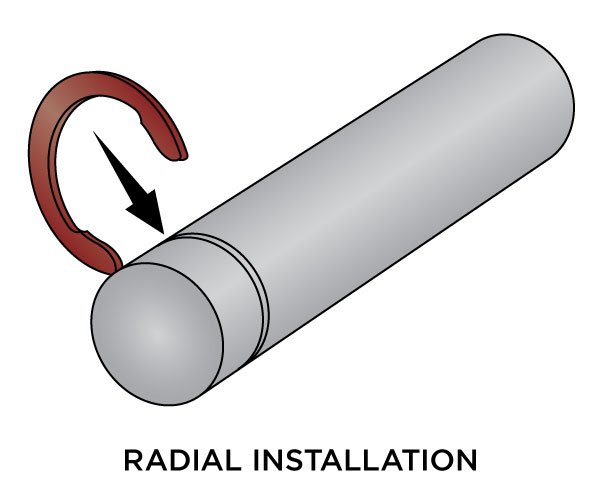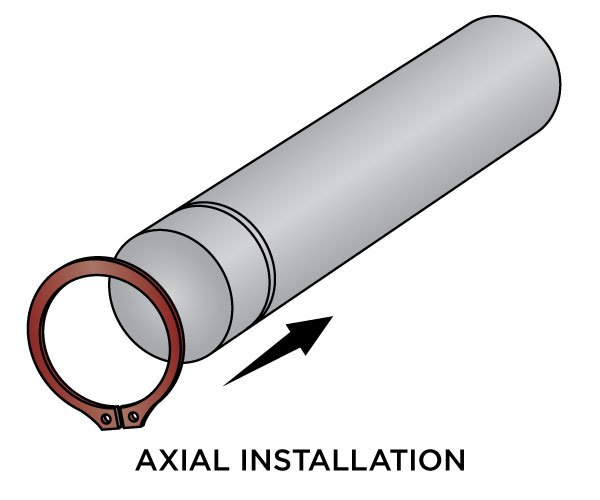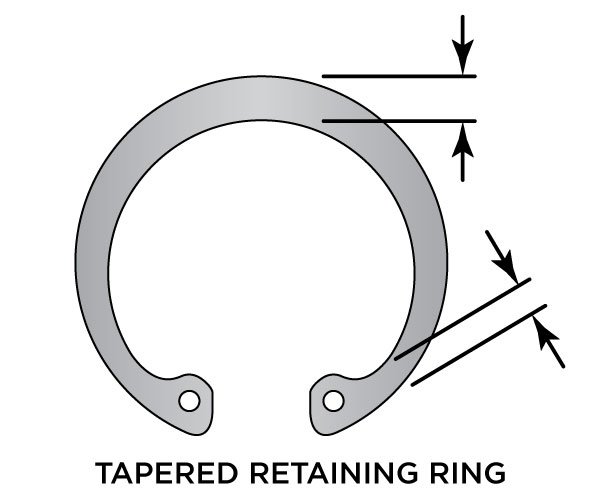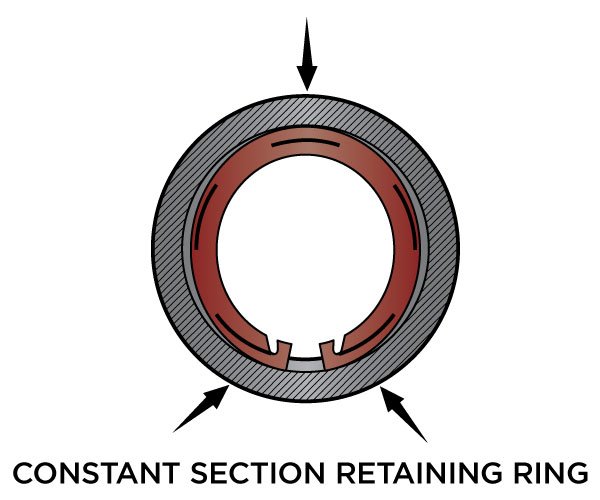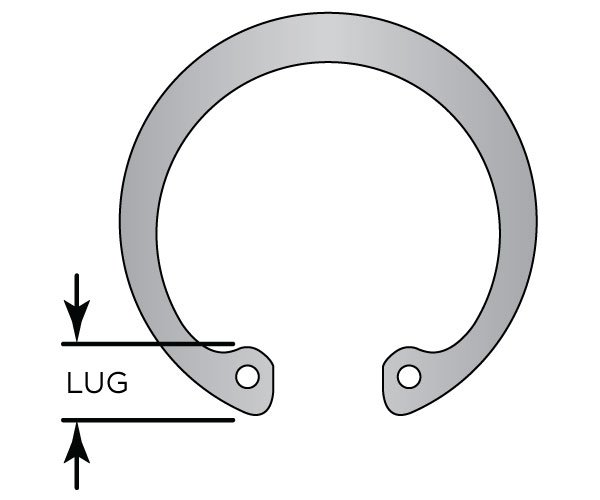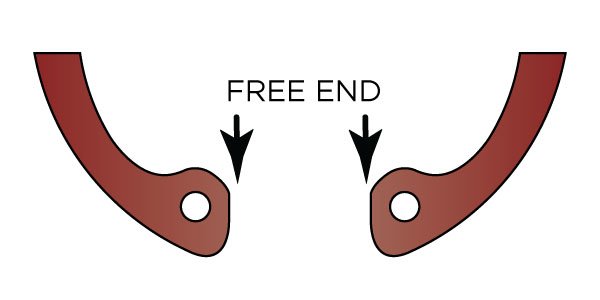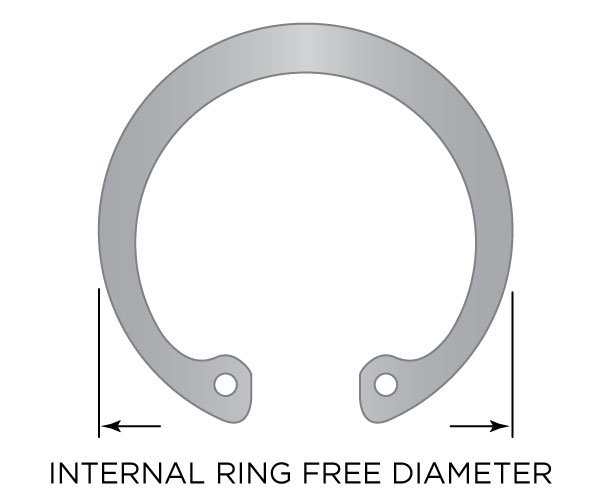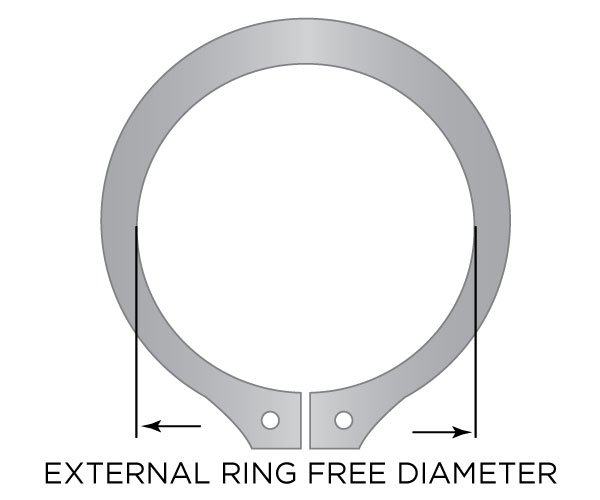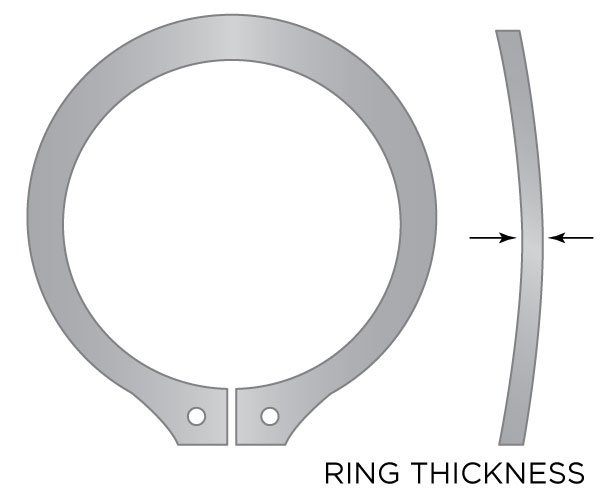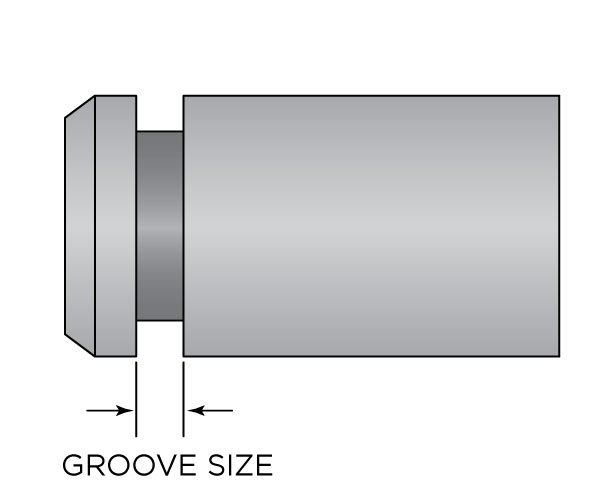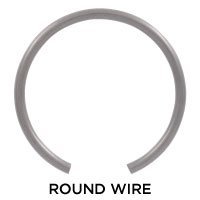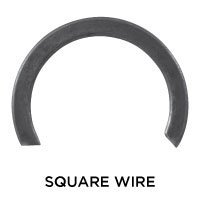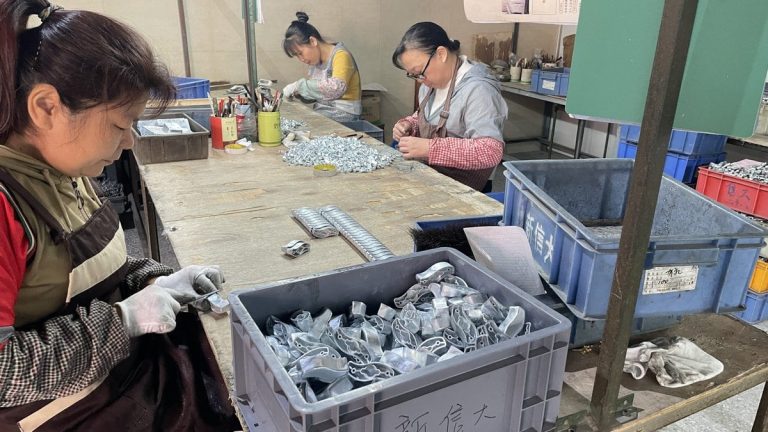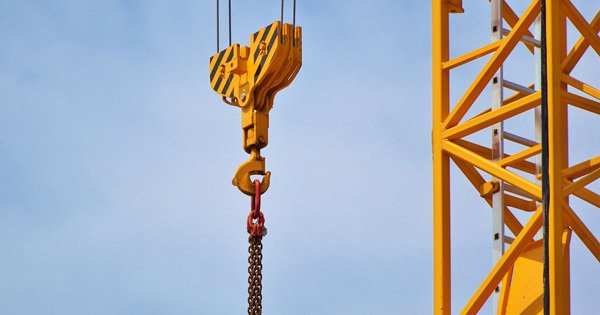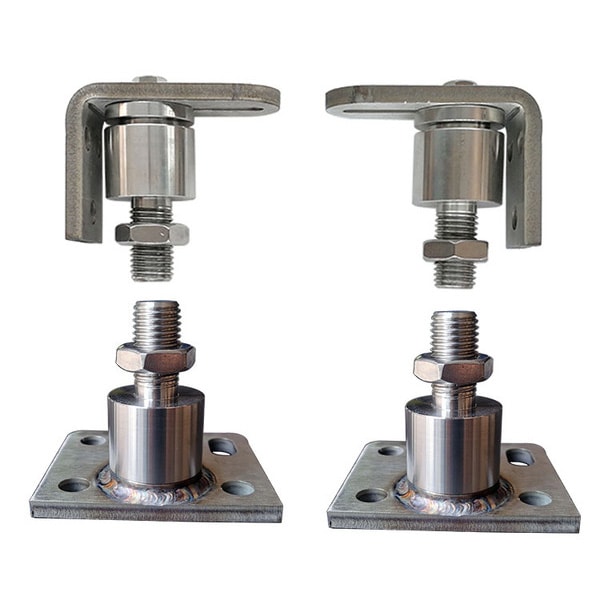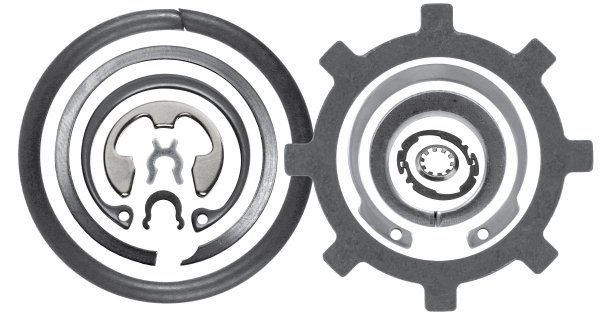
Retaining rings are a broad category of components used to create an internal or external shoulder to retain parts in housings and on shafts. Retaining rings reduce manufacturing complexity and cost, providing an easy-to-install alternative to a machined shoulder. The most widely used of these rings are
snap rings,
housing rings, and
spiral rings, all of which fit into a machined groove on a shaft or in a bore, but there are many other varieties, each with a specific role.
The retaining ring design was patented in 1942 by the family of Jindrich Waldes, a Czechoslovakian inventor and craftsman whose company was converted to a war production facility by Germany in 1939. Waldes himself died after being sent to a concentration camp, but his family had relocated to America by that time.
Allegedly, Allied soldiers captured a German Tiger tank in 1942 and discovered retaining rings as they dismantled the equipment. The Waldes family promptly produced and patented the retaining ring design. In 1953, Bob Slass began his retaining ring career at Waldes. He later founded
Rotor Clip®, one of the world’s leading retaining ring manufacturers.
A Retaining Ring Glossary
Multiple factors impact the design of a machine assembly that uses retaining rings, including how the ring will be installed, the measurement and machining of the groove, and the relation of the ring to the housing and the retained part. We’ll go into greater depth about these in the next section, but first, it is helpful to understand some of the language used to describe retaining rings.
Retaining Ring Installation and Features
- Radially installed retaining ring:
A ring installed by clipping it over the outside of a shaft. This category includes
E-clips, snap rings, and
poodle clips.
- Axially installed retaining ring:
A ring installed along the axis of a shaft or housing. This category includes
housing rings,
snap rings, and
spiral rings.
- Tapered retaining ring:
A ring with a section (see below) of varying depth. This category includes
snap rings and
housing rings.
- Constant section retaining ring:
A ring in which the section is the same around its circumference. This category includes
round wire rings and
square wire rings, among others.
- Lug:
A lug is the widened section of an axially installed retaining ring, usually featuring holes or notches for tool attachment. Lugs allow a tool to compress or expand the ring during installation.
- Free end:
Many retaining rings feature a gap to allow for expansion or compression. The parts of the ring’s circumference surrounding the gap are called free ends.
Retaining Ring and Groove Specifications
- Thrust load capacity:
Thrust loads act along the axis of a housing or shaft. They are the forces a retaining ring absorbs to keep the retained part in place. Both rings and grooves have a maximum thrust load capacity that depends on the materials used, size, and other factors.
- Housing diameter:
The diameter of the housing containing the retained part.
- Side clearance:
The gap between the retained part and the wall of the housing.
- Edge margin:
The distance between the end of a shaft or housing and the groove into which the ring is fitted.
- Free diameter:
The diameter of a retaining ring before it has been installed.
- Radius or chamfer:
A curve or transitional edge at the interface between two edges. For example, retaining ring grooves may have a small radius where the bottom and the wall of the groove meet. Retained parts may have a radius or chamfer where they contact the retaining ring.
- Groove depth:
The height of the groove’s wall.
- Groove diameter:
The distance between the bottom of the groove on opposing sides of the shaft or housing, not to be confused with groove depth.
- Thickness:
The width of the ring measured from front to back. The ring’s thickness determines the appropriate groove width.
- Section or radial depth:
The width of the retaining ring from the inner to the outer diameter. The radial depth is constant in constant section retaining rings and varies around the ring’s circumference in tapered retaining rings.
- Accumulated tolerances:
All machine parts are built to a specific tolerance or degree of precision. They may be slightly oversized or undersized. These slight differences from nominal size combine when parts are joined together, resulting in accumulated tolerances.
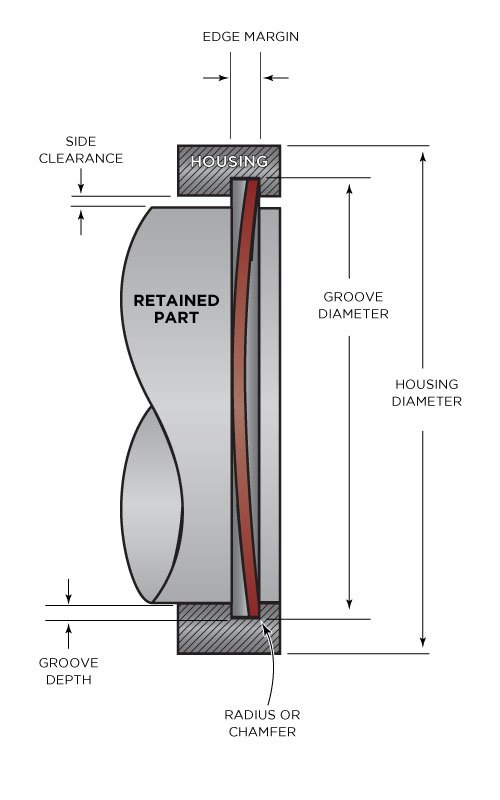
To Groove or Not to Groove?
Most retaining rings are designed to be assembled in grooves. The groove assures proper location of the ring and contributes to its load capacity in the assembly. For many products, however, it isn’t practical to cut a groove and, in some designs, you don’t need one.
The groove is unnecessary, for example, in many electronic instruments, small appliances, toys, plastic products, and other applications where the required shoulder does not need to absorb any sizable thrust load; rather, it positions/locks the device against small vibrations and impacts.
Self‑locking rings do not require any grooves, threads, or other preparatory machining. They are installed quickly and economically because they may be seated at any point on a shaft or in a housing/bore to automatically compensate for accumulated tolerances in the retained parts. Grip rings (pictured left in the image below) may be removed for product adjustment or service; the other self‑locking rings must be destroyed for disassembly.

Factors to Consider When Sourcing a Retaining Ring
Retaining Ring Size
Retaining rings vary across multiple dimensions, but when choosing a retaining ring the most important measurements to consider are:
- Free diameter – For internal retaining rings, this is the outer diameter and for external retaining rings, it is the inner diameter.
- Ring thickness.
- Groove size, including the diameter, width, and depth of the groove.
On huyett.com, these dimensions are displayed alongside each product. For example, the product page for a
5/8 spiral retaining ring shows the groove depth (0.013 inches), free diameter (0.658 inches), and groove diameter (0.651 inches). The groove diameter is usually slightly smaller than the free diameter for internal rings and larger for external rings. It’s important not to confuse the two when selecting a retaining ring.
Product pages also display tolerances for these dimensions. When designing an assembly, be sure to note the groove diameter, depth, and width tolerances. Exceeding these tolerances can negatively impact the ring’s performance.
Thrust Load Capacity
Retaining rings primarily encounter axial forces generating a thrust load. All rings are rated to resist a maximum thrust load, which is determined by the properties of the ring and the groove. If you look at Huyett’s retaining rings catalog page for
external snap rings, you will find thrust load capacities for the ring and groove, both of which include a safety factor. Exceeding thrust load capacities can damage the ring, the groove, and the assembly.
It is important to note that thrust load capacities are calculated for a specific ring and groove configuration. For example, a 1-3/8 external snap ring has a ring thrust load capacity of 8,222 lbs and a groove capacity of 4,100 lbs.
However, these capacities are only accurate when:
- The housing and shaft are made from cold-rolled steel.
- The edge margin is within the recommended range – in this case, over 0.126 inches.
- The groove width and diameter are of the listed dimensions within the listed tolerances.
- The groove is the correct depth with square edges and bottom radii within tolerances.
- There is minimal side clearance between the retained part and the shaft or housing.
Specifications for rings, grooves, and retained parts can be found either on the huyett.com product page or the relevant catalog page PDF linked to on each product page.
It is also important to think about the purpose of a thrust load capacity in your application. If you need rings to position and secure bearings in a pump or lock up components in a car or truck transmission, thrust load capacity can be a critically important factor. On the other hand, if you plan to use a ring to hold a plastic wheel on the axle of a toy truck, chances are you won’t have to worry about thrust loads on the ring.
Rotational Capacity
When fitted to rotating shafts, retaining rings experience centrifugal forces. Excessive rotational speed can cause the ring to lose contact with the bottom of the groove, impacting its performance. External rings are designed to grip the groove’s bottom – the ring’s internal diameter is slightly smaller than the groove diameter – but this is only effective below a specific rotational speed provided in the ring’s specifications. For example, the 1-3/8 external snap ring has an RPM limit of 16,000.
Preferred Installation Method
A retaining ring’s design affects how easy it is to install and remove. Internal snap rings and external snap rings with lugs are straightforward to install with snap ring pliers. Snap rings without lugs are more difficult and time-consuming to install and may require the use of a mandrel or cone. Spiral rings are also more time-consuming to fit, although they can be “wound” into and out of the groove with the help of standard hand tools.
When choosing a retaining ring, consider how often it will be removed and how the length of the installation procedure will impact manufacturing times.
Assembly Clearance
Clearance for retaining rings is important for several reasons. You can choose a specific type that meets all your design requirements, but if you do not have room to install it on the production line, you have a problem. The same holds true for removing and reassembling a ring during inspection, field service, or repairs.
Axial and radial clearance must also be considered in relation to abutting or adjacent components in the assembly. For example, if the lugs of a snap ring get in the way of other parts, you might use an inverted snap ring. You have the same kind of options with radial rings. An E‑clip might be replaced with a C‑clip. The two‑part interlocking rings also assure maximum clearance.
Materials and Finishes
A retaining ring may undergo any number of stresses that could cause wear and tear. Some rings will experience significant rotation, vibration, friction, high speed, etc. Others will be exposed to natural and manmade corrosive elements like rain, extreme temperatures, dirt and debris, salt, sun damage, lubrication, or chemicals.
Along with proper maintenance, one of the key factors in protecting the ring against damage is its material and finish. Different materials and
types of metal finishes offer varying levels of corrosion resistance – for example, carbon steel on its own does not provide much protection, but different types of zinc finishes will fortify the steel against corrosion. Stainless steel, on the other hand, is well-suited to resist natural elements on its own.
Different materials also offer varying levels of
mechanical properties like strength, ductility, hardness, etc. These properties may help the ring withstand repeated stresses, significant motion, or other types of strain.
Want a copy of the Huyett Housing and Snap Ring Size Chart Guide?
Enter your email below to get your FREE download and sign up for our newsletter.
How to Ensure Optimal Retaining Ring Performance
Retaining rings are most effective when they are used in line with the manufacturer’s recommended specifications. As we saw in the previous section, straying from these specifications can significantly reduce performance.
Retaining ring assemblies have two main failure modes:
- The ring “dishes” – bends outwards away from the thrust load – or shears. This usually occurs when the groove material is harder than the ring material.
- The groove shears or yields. This occurs when the ring material is harder than the groove material.
Groove failure is more common than ring failure, primarily because the groove is often in a material that is softer than the ring. The best way to avoid failures is to ensure the ring is not subjected to thrust loads and centrifugal loads beyond its recommended capacity. However, other factors influence ring performance.
Side Clearance, Chamfers, and Radii
Side clearance is the distance between the retained part and its housing. Consider, for example, the distance between the shaft and the bore it occupies. Ideally, this distance is as small as possible. Large side clearances can lead to thrust forces focused unevenly away from the assembly’s strongest point, which is nearest to the groove edge.
Chamfers or radii on the retained part have a similar effect to excessive side clearance. They focus the thrust load in a smaller area towards the ring’s center, creating a bending moment that may cause the ring to dish or the groove to yield. Chamfers or radii on the groove edges compound the problem, which is why groove edges should be as square as possible.
A combination of excessive side clearance, chamfers, and radii increases the likelihood of the ring dishing or the groove shearing or yielding, which may then cause the ring to skew out of the groove – the ring tilts until it is no longer aligned with the axis of the shaft or bore. Many retaining ring specifications include maximum allowable radius and chamfer and a maximum allowable thrust load for assemblies with significant chamfers and radii. You can see these figures for housing rings in our catalog.
Edge Margin
A common retaining ring failure occurs when the groove yields because it is too close to a shaft or housing’s end. Retaining ring grooves are often situated at the end of the mating part, but they must not be so close to the end that the groove’s strength is compromised. Retaining ring specifications include a minimum edge margin, but a useful rule of thumb is that the edge margin should be at least three times the groove depth.
Tolerance or End Play
In many products, accumulated tolerances or wear in the retained parts can cause objectionable end play in the assembly. There are two types of rings you can use to avoid this:
- Bowed rings, which are designed to provide resilient take up by functioning as both spring and fastener. In addition to compensating for end play, they can also be used to dampen vibration and oscillation.
- Beveled rings, on the other hand, provide rigid end play take up by functioning as a wedge between the retained part and the load bearing groove wall.
Both styles are available in different types for axial assembly, and only the bowed are available in radial assembly.
Types of Retaining Rings
There are many types of retaining rings, each with advantages and disadvantages. In this section, we’ll explore the most popular retaining rings available from Huyett and when they should be used.
External Retaining Rings (Snap Rings)
External retaining rings, also known as snap rings and circlips, are designed to fit on the outside of a shaft. The lugs protrude outwardly to keep the internal diameter free of interference.
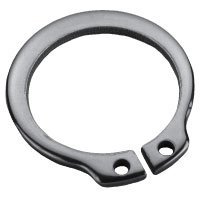
Internal Retaining Rings (Housing Rings)
Internal retaining rings, also widely known as housing rings, are designed to fit on the inside of a shaft or bore. The logs protrude inwardly to keep the external diameter free of interference.
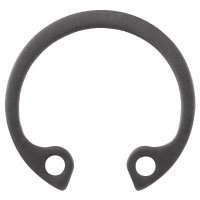
Snap Ring and Housing Ring Characteristics
These rings are both axially installed tapered retaining rings with lugs to aid installation and removal with snap ring pliers. Their tapered section design allows them to maintain all-round contact with the bottom of their groove.
Both snap rings and housing rings are capable of supporting high thrust loads and they are easy to install or remove. They are used to retain axles, shafts, bearings, and many other components. In some applications, the lugs may be undesirable due to interference with other components, in which case a
spiral ring or other type of complete circumference retaining ring might be more suitable.
Each type of ring includes several variations on the standard design:
- Tabbed snap rings feature a series of tabs around their inner diameter.
- Inverted internal snap rings and
inverted external snap rings feature reversed lug positions compared to standard snap rings.
- Beveled internal snap rings and
beveled external snap rings feature a 15° bevel on their exterior or interior edge respectively. The bevel helps to reduce end play by occupying space between the groove and the retained part.
- Bowed internal snap rings and
bowed external snap rings are curved so they exert a force against the retained part. They are useful for reducing end play and compensating for accumulated tolerances.
Spiral Retaining Rings
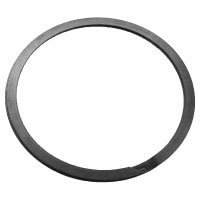
Spiral retaining rings are made from coils of flat wire that provide 360° contact with the groove and retained part because they do not have lugs or a gap. They are typically installed by separating the coiled wire and “winding” the coils into the groove. Spiral rings are easy to install without special tools, but they can be more time-consuming to install and remove than snap rings.
Standard spiral rings are generally less suited to high RPM applications than tapered snap rings, as they more easily expand away from the groove, especially when the rotation is in the opposite direction of the coils.
Spiral retaining rings are available in both
internal spiral ring and
external spiral ring varieties.
E-Clips
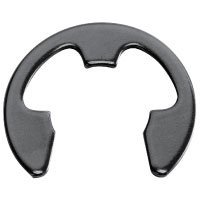
E-clips are radially installed external retaining rings with three flat internal prongs or tabs. The primary benefit of E-clips is their wider shoulder compared to other types of external retaining rings. This gives them a wider retaining area and thus a higher thrust load capacity. E-clips are the most widely used radially installed external retaining ring and they are frequently used to hold gears in position on a shaft and to hold shafts on bearings.
In addition to standard E-clips, specialist variants include:
- Reinforced E-clips, which accommodate higher thrust loads and RPMs while occupying the same groove as a standard E-clip.
- Bowed E-clips, which are curved to reduce end play and account for accumulated tolerances.
Poodle clips are a heavy-duty alternative to E-clips. They are made from thicker material and feature ears that provide a larger retaining surface.
Crescent Rings
Crescent rings, also known as C-clips, are similar to E-clips, but they lack the latter’s teeth and large tabs. Consequently, crescent rings are suitable for low-clearance applications in which the larger E-clip may interfere with other components. The trade-off is that crescent rings have a lower thrust load capacity than E-clips.
Interlocking Rings
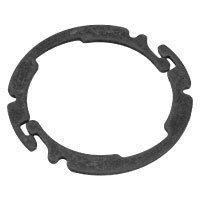
Interlocking shaft rings are radially installed external retaining rings designed to solve a problem we’ve mentioned several times: the tendency for retaining rings to separate from their groove in high RPM scenarios. Interlocking shaft rings are made of two parts that lock together around a shaft. The two halves are balanced and the strong interlocking mechanism holds them in place. Interlocking rings are an excellent option in high RPM scenarios which are not ideal for snap rings and spiral rings.
Round Wire, Square Wire, and Rectangular Wire Rings
This category of retaining rings includes a variety of constant section rings that differ by the cross-sectional shape of the wire used to make them. They are available with a wide range of gap sizes, allowing for both radial and axial installation. They are used in many bearing assembly and retention applications.
The wire’s shape gives the rings distinct properties:
- Internal and
external round wire rings fit in half-round grooves and are manufactured to tighter tolerances than square and rectangular varieties.
- External
square wire rings provide a stronger shoulder than round and rectangular wire rings, which makes them more suitable for heavy-duty applications.
- Rectangular wire rings have a wider shoulder than round and square rings.
X-Rings

X-Rings are radially installed retaining clips that feature a pair of “legs” that can be crimped together. They are placed into a groove and secured by squeezing the legs together with pliers. X-rings are extremely versatile, and they can be used in a huge range of applications to hold grooved shafts or pins in place.
Crimp Rings

Crimp rings are axially installed retaining rings. They are flat constant section rings with a gap. Following installation on a grooved shaft, the ring is crimped to close the gap and provide a strong hold.
Push-On Retaining Rings

Push-on retaining rings are axially installed self-locking rings that don’t require a grooved shaft or bore. They feature a series of tabs that grip the mating part, providing a friction force to stop them from sliding axially along the shaft or bore. They are easy to install and do not require additional machining, making them an ideal retaining solution for light-duty applications with minimal thrust loads.
Grip Rings

Grip rings are radially installed retaining rings with a self-locking mechanism. Because grip clips self-lock, they can be used with both grooved and ungrooved shafts, provided the shaft is made of a softer material than the ring. Grip rings are often used as an easily installed solution for retaining parts on ungrooved shafts.
Find the Best Retaining Ring for Your Application with Huyett
Huyett stocks an extensive assortment of retaining rings. To find the perfect retaining ring for your application, view the full selection on huyett.com and visit our
Retaining Ring FAQ.

